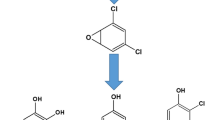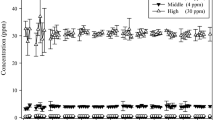Summary
Three volunteers were exposed to fluorotrichloromethane (R-11) under experimental conditions. Solvent levels in ambient and alveolar air, in blood and urine were measured. The mean concentration of R-11 in ambient air was 657 ml/m3. The average values of pulmonary retention and solvent levels in alveolar air and blood were 18.2%; 537 ml/m3 and 2.8 mg/l. Interindividual variations of these parameters are negligible. R-11 concentrations in urine—in contrast to blood or alveolar air—depend on the dose taken up. After termination of exposure, R-11 concentrations in alveolar air and in blood are excreted with biological half-lives of seven and eleven minutes respectively during the first phase of elimination and with 1.8 and 1.0 h respectively during the second phase of elimination. Though ambient monitoring should, in most cases, be sufficient for the prevention of occupational diseases, the R-11 concentration in alveolar air seems to be the best parameter if biological monitoring seems to be necessary.
Similar content being viewed by others
References
Adir J, Blake DA, Mergner GW (1974) Kinetics of uptake and elimination of trichlorofluoromethane (F-11) and dichlorodifluoromethane (F-12) in beagles and humans. Toxicol Appl Pharmacol 29:142
Angerer J (1983) Prävention beruflich bedingter Gesundheitsschäden durch Benzol, Toluol, Xylole und Ethylbenzol. Band 71 der Schriftenreihe Arbeitsmedizin, Sozialmedizin, Präventivmedizin. AW Gentner Verlag, Stuttgart
Angerer J, Machata G (1978) Head-Space-Technik-Sammelmethode. In: Henschler D (ed) Analytische Methoden zur Prüfung gesundheitsschädlicher Arbeitsstoffe. Angerer J, Schaller KH: Bd 2, Analysen in biologischem Material, Deutsche Forschungsgemeinschaft, Verlag Chemie, Weinheim [3. Lieferung]
Åstrand J, Ehrner-Samuel H, Kilbom Å, Övrum P (1972) Toluene exposure. I. Concentration in alveolar air and blood at rest and during exercise. Work Environ Health 9:119–130
Blake DA, Mergner GW (1974) Inhalation studies on the biotransformation and elimination of 14C trichlorofluoromethane and 14C dichlorodofluoromethane in beagles. Toxicol Appl Pharmacol 30:396–407
Brugnone F, Nardelotto O, Guidice S (1981) Monitoraggio dell'esposizione professionale a fluorocarburi mediante l'analisi dell'aria alveolare e del sangue. Med Lavoro 6:480–487
Carlsson A, Ljungquist E (1982) Exposure to toluene. Concentration in subcutaneous adipose tissue. Scand J Work Environ Health 8:56–62
Deutsche Forschungsgemeinschaft (1984) Maximale Arbeitsplatzkonzentrationen und Biologische Arbeitsstofftoleranzwerte. Mitteilung XX der Senatskommission zur Prüfung gesundheitsschädlicher Arbeitsstoffe. Verlag Chemie, Weinheim
Dollery CT, Draffan GH, Davies DS, Williams FM, Conolly ME (1970) Blood concentrations in man of fluorinated hydrocarbons after inhalation of pressurised aerosols. Lancet II:1164–1166
Eddy CW, Griffith FD (1972) Metabolism of dichlorodofluoromethane-C14 (Freon 12 C14) by rats. Am Ind Hyg Ass J 33:736
Heinrich R, Schröder B, Angerer J (1984) Zur Grenzwertfindung bei Trichlorfluormethan (R-11)-Belastung. In: Konietzko H, Schuckmann F (ed) Verhandlungen der Deutschen Gesellschaft für Arbeitsmedizin eV, 24. Jahrestagung in Mainz vom 2.–5. Mai 1984. Gentner Verlag, Stuttgart
Henschler D (1972) Gesundheitsschädliche Arbeitsstoffe, toxikologisch-arbeitsmedizinische Begrundung von MAK-Werten. Deutsche Forschungsgemeinschaft, Verlag Chemic, Weinheim [1. Lieferung]
Machata G (1983) Persdnliche Mitteilung
Morgan A, Black A, Belcher DR (1972a) Studies on the absorption of halogenated hydrocarbons and their excretion in breath using 38C1 tracer techniques. Ann Occup Hyg 15:273–282
Morgan A, Black A, Walsh M, Belcher DR (1972b) The absorption and retention of inhaled fluorinated hydrocarbon vapors. Int J App] Radiat Isot 23:285–291
Paterson JW, Sudlow MF, Walker SR (1971) Blood-levels of fluorinated hydrocarbons in asthmatic patients after inhalation of pressurised aerosols. Lancet II:565–568
Stewart RD, Baretta ED, Herrmann AA, Forster HV, Crespo JH, Newton PE, Soto RJ (1975) Acute and repetitive human exposure to fluorotrichloromethane. Report No. IASS-CTFA-MCOW-ENVW-F11-75-1, NTIS PB-279 203, US Department of Commerce, Springfield, VA 22 161
Author information
Authors and Affiliations
Rights and permissions
About this article
Cite this article
Angerer, J., Schröder, B. & Heinrich, R. Exposure to fluorotrichloromethane (R-11). Int Arch Occup Environ Health 56, 67–72 (1985). https://doi.org/10.1007/BF00380702
Received:
Accepted:
Issue Date:
DOI: https://doi.org/10.1007/BF00380702




